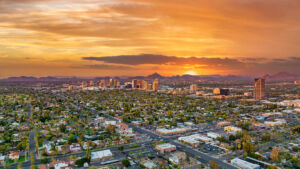It’s not entirely clear when or where this competition started, but clues point to Silicon Valley as the origin of these highly-competitive office amenities games.
“I think we can all agree that the tech industry started this trend and continues to be the catalyst to sustain this trend,” said John Orsak, director of real estate for Lincoln Property Company. “The Googles of the world were creating campuses that gave an incentive for employees to stay at work longer.”
Office complexes began rolling out amenities for their tenants that were previously unheard of. Fitness centers with locker facilities, free or inexpensive meal options, dry cleaning and transportation options drew widespread attention when they began popping up on corporate campuses. In the late 1990s and early 2000s, tech companies were miles ahead of the competition, but new office facilities are catching up, and perhaps even passing those trendsetters. Building owners know that in order to keep pace or stay ahead of the competition, they must provide winning amenities, and the businesses that lease space in these buildings need those amenities as well.
“The competitive environment to recruit and retain employees is pushing the facility amenities,” said Bryan Taute, executive vice president at CBRE. “The buildings with the best amenities are typically leasing faster and getting higher rents.”
“The buzz around amenities outweighs the number of buildings that actually have amenities to offer,” added Chris Walker, managing director at Cushman & Wakefield in Phoenix. “Those that provide them and provide them in a well thought out, impactful manner, will likely see increased occupancy and potentially will be able to hold rental rates better than the competition.”
How office developers and building owners decide what amenities to incorporate in their facilities depends on the market and what type of tenant they are trying to appeal to.
“On the front end, we analyze the profile of the tenants in the complex and those that we want to attract,” said Steven Schwarz, founding partner at ViaWest Group. “We then brainstorm what drives those tenants’ decisions and actions. For example, it could be maximizing time for a wealthy demographic (like lawyers, accountants and real estate brokers), in which case laundry delivery, on-site car wash and some concierge services are most significant. In other cases, a tenant could want random collisions, so a gathering place is more appropriate.”
Another factor that owners must consider is how much space to devote to amenities. After all, a 2,000-square foot fitness facility that rarely gets used is space that could be leased to a tenant.
“We are being very considerate of how these spaces can turn back into rentable square footage,” said Jennie Mayer, principal at Phoenix Design One. “Generally, we try to take the undesirable spaces in the property to install these amenities. Views to the smoking area can easily be a café. Very little natural light suites can become conference centers.”
So what are the basic, must-have amenities; what amenities will draw a lot of attention and what are the gold medal-winning amenities that put office owners on top of the podium? Let’s take a look:
Bronze
These are the must-have amenities in every office. Without these, offices will struggle to attract high-quality, long-term tenants.
Premium building finishes with modern design: First and foremost, the facility must look good. “You’re looking for expensive finishes, unique elements to the space, furniture with function and design, etc.,” said Orsak. “You can no longer slap down new carpet and paint an accent wall or two.”
Fast, reliable Wi-Fi: This is a must in modern office environments. Employees need to stay connected, no matter where in the complex they may be.
Shared meeting spaces: Companies want to lease as little space as they can to lower costs, so they may not have their own spaces for larger gatherings. Access to a meeting space with modern technology like video and audio conferencing and a projection system is important.
Restaurant or coffee house on site: Tenants want their workers to stay at work, so having coffee or food options within walking distance is important.
Ample parking: Struggling to find a place to park should not be the first task employees face when they come to work. New office facilities are being built with large parking structures to ensure tenants aren’t scrambling for spots on the street or in pay lots.
Silver
Some of these amenities may be outside-the-box concepts, but fit perfectly for select tenants and get the attention of the executives making the decisions about where to locate their office.
Food options: While an on-site restaurant is nice, the choices are likely very limited. In order to appeal and serve a larger number of employees, office facilities that are isolated from areas with restaurant options are getting creative.
“We are seeing more food options with the advent of food trucks and Fooda,” said Schwarz. “Many buildings without on-site amenities are able to solve this amenity issue without using up rentable square feet.”
Fooda is a service that partners with local businesses to set up pop-up restaurants on site. Individual companies or office complexes can bring in a rotating group of restaurants to serve employees. Food trucks and Fooda provide more options to keep tenants well-fed and happy.
Fitness center with locker facilities: Building owners have a love/hate relationship with on-site fitness centers.
“Every prospective tenant asked to see the gym on the tour,” said Orsak. “You really have to check that box, but in practice, that fitness center gets more tours than actual users it seems.”
While it may not get used much, the well-equipped fitness center is an eye-catcher for perspective renters and one that both the landlord and tenant can brag about having.
“A number of amenities are definite check-the-box items, such as light rail and a gym,” Schwarz said. “However, generally speaking, neither of these are as heavily used as the corporate decision maker thinks.”
Tech-free areas and quiet spaces: During a busy workday, sometimes the best thing for an employee is to unplug and unwind for 15 minutes and providing spaces to do that is becoming more common.
“For years we have been designing to try to connect people in spontaneous ways,” said Mayer. ”It seems people are becoming a bit more introverted. I believe that is because technology and social media actually isolate us and make us a little more lonely.
“We’re seeing living rooms or other communal spaces that are tech free. Resimercial design, which is commercial spaces with a residential fit and finish or feel is more common. I think we may also see virtual reality rooms in the future and prayer/meditation rooms.”
Gold
Amenities like these draw and hold the best tenants and provide a winning office environment.
Concierge services: A busy executive has little time to handle many common non-work tasks, like going to the dry cleaners, buying groceries or getting car repairs. A concierge service can handle those tasks so the employee can focus on the job while at work and have more time to spend with family at the end of the day.
Pet friendly environment: More and more workplaces are allowing pets, and some are even catering to them with on site grooming facilities and dog runs. However, for multi-tenant office complexes, allowing pets can be somewhat problematic.
“While not necessarily outlandish, we have heard discussion in the market of creating spaces that are pet friendly within the common space of an office building,” said Walker, “which seems to be a little different than what you would expect in an office space.”
Wellness programs: Fitness centers are nice, but if a person struggles for motivation and direction, they will steer clear of them. A wellness program can give participants guidance and the added benefit of being part of a group.
“One of my largest tenants has integrated an entire wellness program and is on track to be the first WELL certified building in the Valley,” said Mayer. “We designed a full service gym with yoga and spin room, focus rooms for quiet reflection, mother/nursing rooms, a full service cafeteria with operator that implements a WELL menu which has strict regulations for sugar content and calorie counts. We designed in a ‘track’ represented by a flooring change for users to get in their steps, and water bottle filler stations were within 75 feet of any direction.
“We are seeing that larger tenants are implementing wellness as a way of life in the workplace and our design philosophy is to implement this whenever we can. Not only through design but through case studies that encourage tenants that this does improve productivity.”
Modern work environment: For some, a modern workspace has adjustable monitors that allows employees to sit or stand at their desk. For others, a modern workplace means there are no desks, just places to sit and work, either alone or with a group and at any time of day.
“I see more flexible work environments that aren’t traditional 9-to-5 hours,” said Taute.
For building owners, this free-flowing trend will mean designing spaces with more open floorpans with less private office space.
“In 5 years, I believe we will not need as much real estate. People may not need an actual desk or office to work in,” added Mayer. “We may see it go totally mobile with less office and workstation and more communal work space.”
“‘Tech’ is a buzzword and there is a push to make buildings more modern and ‘techy’ to capitalize on the influx of tech companies,” added Walker. “Appealing to the younger generation requires changing the mindset of the ‘traditional model’ and utilizing forward thinking to offer competitive space that is appealing to their values and culture.”
Transportation solutions: Getting to work can be a major challenge for many employees, so offices are trying to provide amenities that make the commute less of a hassle. Ride-share programs as well as designated ride-share drop-off areas, buildings close to light rail stations and bike parking and repair facilities are just some ways offices are helping ease the stress of getting to the office.
“Bike storage is gaining in popularity because people are trying to be more urban,” said Taute.
Tenant lounge or community gathering spaces: Spaces that employees can gather and socialize are vital to tenant satisfaction.
“The less important amenities on a prospect tour, such as liquor lockers, ping-pong tables, and well-located/multi-use tenant lounges receive more utilization than typically anticipated,” said Schwarz.
The most sought-after of these spaces are the elevated, or rooftop, outdoor lounges. Some of these modern lounges throw in the extra perk of providing liquor lockers for the tenants. Buildings that have rooftop lounges definitely stand out from the crowd.
“Our new project, The Grand 2, will have over 20,000 square feet of amenity space between a ground floor café, conference center, fitness facility and a stunning rooftop lounge,” Orsak said. “Much of that space could have been monetized through leasing, but we made the easy decision as the owners and developers to include those vital amenity spaces in the project.”



